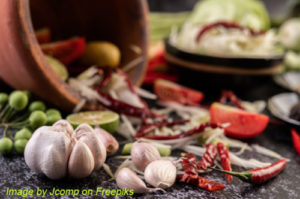Patis or fermented fish sauce is the root word of “pinatisan”. This sauce is actually a condiment like soy sauce because is salty and a good substitute to salt because it add flavor to the dish like MSG. Pinatisang baboy is sauteing garlic and stewing pork intestines, pork meat and liver in fermented fish sauce. This dish is easy to cook with few ingredients like the meat, spice and seasoning.
The Essence of Patis in Filipino Cuisine
Patis plays a crucial role in Filipino cooking. It’s not just a condiment but an essential ingredient that imparts a distinctive umami flavor to various dishes. Historically, patis has been used in Filipino households as a natural flavor enhancer. Its origins can be traced back to the early methods of fish fermentation practiced by coastal communities. Patis is often compared to soy sauce, yet it has a more pronounced and robust flavor. In dishes like this, patis not only adds saltiness but also deepens the overall taste, making the dish richer and more savory.
Preparing the Pork Intestines for Pinatisang Baboy
The first step in making pinatisang baboy is preparing the pork intestines. This process might seem daunting, but it’s relatively straightforward. The small intestines are turned inside out and rubbed with salt. This step is essential for cleaning the intestines thoroughly and removing any impurities. After rubbing with salt, the intestines are rinsed well with water. This ensures that they are clean and ready for cooking. Proper preparation of the intestines is crucial for achieving the desired texture and flavor in the final dish.
Cooking the Intestines to Perfection
Once cleaned, the pork intestines are boiled in water over low heat for about an hour until they become tender. This slow cooking process allows the intestines to soften and absorb the flavors of the water. Cooking the intestines properly is key to ensuring they are tender and not chewy. Tender intestines contribute to the overall texture of the dish, making it more enjoyable to eat. This step is vital for achieving the perfect consistency in the dish.
Sautéing the Ingredients or Pinatisang Baboy
After the intestines are cooked, the next step involves sautéing. Heat some cooking oil in a pan and brown the garlic. The aroma of browned garlic is the hallmark of many Filipino dishes, and it sets the foundation for the flavor profile of this dish. Once the garlic is browned, the small intestines, pork meat, and liver are added to the pan. These ingredients are mixed well and allowed to cook together, ensuring that each piece absorbs the flavors of the garlic and oil.
The Magic of Vinegar and Patis
Adding vinegar and patis to the mix brings the dish to life. Vinegar adds a tangy element that balances the saltiness of the patis, creating a harmonious blend of flavors. In Filipino cuisine, vinegar is often used to cut through the richness of meats and provide a refreshing contrast. Patis, on the other hand, deepens the umami taste, making the dish more savory. Additionally, half a cup of meat broth is added to the pan, which enhances the richness of the dish and provides the necessary liquid for simmering.
Simmering for Perfection
After adding the vinegar, patis, and meat broth, the pan is covered, and the mixture is brought to a boil. The dish is then simmered over low heat for 30 minutes. This slow simmering process allows the flavors to meld together beautifully. The pork intestines, meat, and liver absorb the flavors of the garlic, vinegar, and patis, resulting in a deeply flavorful and aromatic dish. The simmering also helps to tenderize the meat further, making it succulent and delicious.
Serving Pinatisang Baboy
The dish is best served hot, allowing you to fully appreciate its rich and savory flavors. This dish is typically enjoyed with steamed rice, which helps to balance the strong flavors of the patis and vinegar. Pinatisan makes for a hearty meal that is perfect for sharing with family and friends. Its unique combination of ingredients and flavors showcases the ingenuity of Filipino cuisine, where simple ingredients are transformed into a delectable dish.
Food for Thought: The Cultural Significance of Pinatisan
Pinatisanng baboy is more than just a dish; it’s a reflection of Filipino culinary traditions and the resourcefulness of using every part of the animal. Historically, dishes like this were created to ensure that no part of the animal went to waste. The use of pork intestines and liver highlights a nose-to-tail approach to cooking, which is both sustainable and economical. Moreover, the use of patis connects modern Filipino cuisine to its historical roots, preserving the flavors and techniques passed down through generations. Enjoying the dish is not just a culinary experience but also a journey into the rich history and culture of the Philippines.
How to Cook Pinatisan (Pork Sauteed in Patis)
Ingredients
- 1/2 kilo sliced cleaned & cooked small pork intestines 2 inch lengths
- 1 tablespoon cooking oil
- 1 teaspoon minced garlic
- 1/4 kilo lean pork sliced
- 1/2 cup sliced pork liver
- 1/4 cup vinegar
- 2 tablespoons patis
- 1/2 cup meat broth
Instructions
How to cook pinatisan:
- Turn small intestines inside out and rub with salt. Rinse well with water.
- Boil 2 cups water and add small intestines.
- Cook over low heat for one hour until tender.
- Heat cooking oil and brown garlic. Mix in small intestines, pork and liver.
- Add vinegar, patis and 1/2 cup meat broth. Cover and bring to a boil.
- Simmer over low heat for 30 minutes. Serve hot. Makes six servings.
Notes
Cooking Tips for Pinatisang Baboy
Proper Cleaning of Pork Intestines To ensure the best texture and taste, thoroughly clean the pork intestines by turning them inside out and rubbing them with salt. This step removes impurities and reduces any unwanted odor. Rinse well with water to prepare the intestines for cooking. Achieving Tender Meat Boil the pork intestines in water over low heat for about an hour to achieve optimal tenderness. This slow cooking process allows the intestines to soften and become more palatable. Tender intestines enhance the overall texture and enjoyment of the dish. Balancing Flavors When adding vinegar and patis, be mindful of the balance between tangy and salty flavors. The vinegar provides a refreshing contrast to the richness of the patis, creating a harmonious taste. Simmering the mixture for 30 minutes ensures the flavors meld perfectly, resulting in a deliciously balanced dish.





